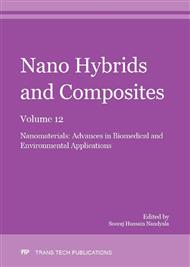p.9
p.21
p.33
p.42
p.51
p.57
p.67
p.74
p.79
Highly Efficient Yttrium Based Metal Organic Framework for Removal of Pollutant Dyes
Abstract:
Highly porous crystalline luminescent metal Organic Frameworks (MOFs) were synthesized by conjugating Yttrium nitrate and Benzene Tri Carboxylate (BTC) in the presence of surfactant Cetyl Tri methyl Ammonium Bromide. A characteristic blue emission peak around 400 nm of Y upon excitation with UV light and peaks through Infra-Red spectroscopy revealed the formation of co-ordinate bond between Y and BTC, thereby confirming the formation of MOF nanoparticles (NPs). The nanoparticles were studied for potential removal of pollutants by encapsulation of the dye methylene blue (MB). Optical analysis affirmed the encapsulation of dye particles within the porous MOF NPs as dye absorption decreased around 600nm. This study offers great promise of using MOF NPs as platform for sensing of analytes in solution and removal of pollutant materials.
Info:
Periodical:
Pages:
51-56
Citation:
Online since:
November 2016
Price:
Сopyright:
© 2017 Trans Tech Publications Ltd. All Rights Reserved
Share:
Citation:


